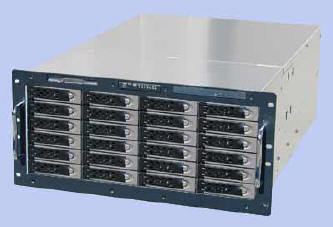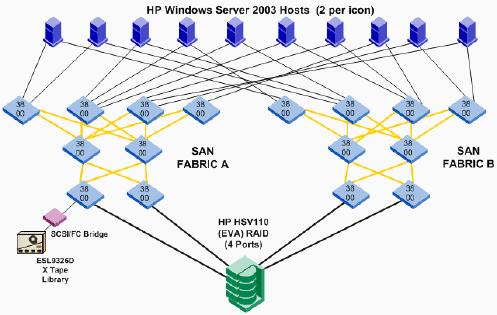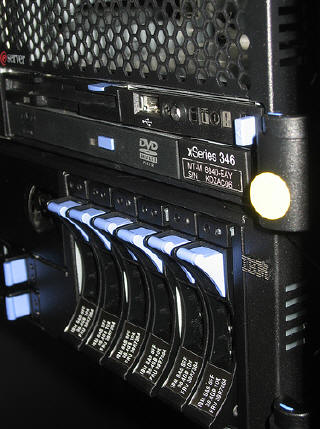Enterprise Data Storage
Definition: Enterprise storage is a centralized storage system that businesses use for managing and protecting data. It also enables data sharing through connectivity to various computers in a network environment that includes UNIX, Windows 2000 and mainframe platforms.
Enterprise storage differs from consumer storage with respect to the size of the storage operations and also the technology used. When considering the implementation of an enterprise storage technology, enterprises should
appraise the technology on four parameters.
These include storage,
backup, archiving, and
disaster recovery. Together, these four constitute the major functions of an enterprise storage system and they impact both cost and performance.
Challenges faced by today’s enterprise storage solutions:
Explosive data growth caused by concurrent requirement for historical, integrated, and granular data.
Requirement for alternate storage mechanisms so that infrequently used “dormant data” can be stored in a more cost-effective manner.
Enterprise business storage has to cater to an
increased number of users including data miners, explorers, departmental users, multidimensional users, power users, and executive users.
 Enterprise business storage plays a key role in ensuring that enterprise business intelligence is available to be leveraged at the most opportune moment and that discrete data silos are consolidated to provide an enterprise
business intelligence infrastructure. Enterprise business storage plays a key role in ensuring that enterprise business intelligence is available to be leveraged at the most opportune moment and that discrete data silos are consolidated to provide an enterprise
business intelligence infrastructure.
Storage System Types:
The three basic storage systems are direct attached storage (DAS),
storage area network (SAN) and
network attached storage (NAS).
DAS is the basic building block on which SAN and NAS can be deployed. Thus, DAS which constitutes block-level storage dictates the performance of SAN and NAS and ultimately the entire enterprise storage environment. The host computer’s storage interface is connected to DAS. A data network is required so that computers other than the host computer can access DAS.
The storage devices that are used to develop a DAS storage subsystem include SCSI, PATA, SATA,
SAS, FC, Flash, and RAM.
SANs offer greater functionality than DAS as they allow more than one host to connect to a single storage device at the block level. This enables server computers to systematically control the storage volume in a storage device. However, multiple clients cannot share a single volume. SAN offers a host of compatibility advantages with respect to applications. SAN technologies include
iSCSI, FC, and AoE.
NAS is essentially a file server that resides on top of SAN or DAS. NAS ensures Microsoft compatibility by using server message block (SMB) and network file system (NFS) for UNIX compatibility. Unlike SAN or DAS, NAS allows multiple clients to share a single volume. The drawback of NAS is that it does not offer compatibility with as many applications as SAN or DAS; this is because most applications run with a block-level storage device.

Selecting the right storage alternative:
Apart from the obvious need of storing data, an enterprise data storage solution has to fit the bill for many other requirements. These include protection against network security threats,
backup plans,
disaster recovery setup, and also compliance with legislations on the process of storing, managing, and archiving data. Data integrity and privacy are of special importance to the healthcare and finance industry.
When selecting an enterprise
storage solution, you should focus on your organization’s long-term business goals and particular requirements.
Factors you need to take into consideration include:
-
The amount and type of data
Performance as measured by I/O and throughput requirements
- Availability of reliable data for mission-critical applications
- Scalability
- Budget
- Backup and
-
Recovery
Enterprise storage usually consists of a mixed storage environment that includes DAS, NAS, and SAN.
In an enterprise with a small number of
servers, DAS serves the purpose for localized file sharing. It also serves as the
platform on which SAN and NAS are located; in this situation management and administration complexities are reduced because DAS can be managed through the network operating system of the attached server.
A DAS calls for low initial investment. Additional storage capacity can be added as per requirement. The complexities of a networked storage are avoided. DAS also serves as a stop-gap arrangement for enterprises that wish to migrate to a NAS environment at a later date. After the transition to a networked storage, legacy DAS can still be used to store non-critical data.
NAS, which comprises both hard disks and management software, is used where a server-based infrastructure is insufficient to meet enterprise storage needs. NAS is used only for file-sharing; this means that the server can be used for application sharing. This separation of functionalities speeds up data access for multiple clients over the network. Enterprises being served with DAS can improve utilization of storage by incorporating NAS which enables storage to be shared across multiple servers. In a NAS/SAN convergence, NAS offers reliability features such as
RAID and
enterprise and data protection features such as
replication and mirroring. convergence, NAS offers reliability features such as
RAID and
enterprise and data protection features such as
replication and mirroring.
NAS is viewed as a value proposition that delivers high performance; it offers a strong case of business and ROI as a technology investment. Enterprises now focus on expanding NAS capabilities because it is scalable and offers high volumes of data storage in high density form factors which conserves data center space. NAS systems can integrate into environments that may be running Windows, Mac and Linux
workstations. This enables heterogeneous data sharing.
SANs are implemented for mission-critical applications. They constitute a dedicated and high performance network for data transfer between servers and storage devices. They operate in isolation from a LAN. Data in a San network is moved using Fiber Channel, which can transfer high volumes of data and facilitate instantaneous communication between workstations and mainframes. SAN is ideal where moving large chunks of data is the need; scenarios include database, image and transaction processing. Dynamic load balancing enables fast data transfer, and reduced latency. SANs ensure 24x7 data availability.
The downside to a
SAN storage system is the cost, complexity in management and lack of standardization. This can be countered to some extent by opting for a NAS/SAN implementation since the two technologies complement each other quite well.
|
 Enterprise business storage plays a key role in ensuring that enterprise business intelligence is available to be leveraged at the most opportune moment and that discrete data silos are consolidated to provide an enterprise
Enterprise business storage plays a key role in ensuring that enterprise business intelligence is available to be leveraged at the most opportune moment and that discrete data silos are consolidated to provide an enterprise

